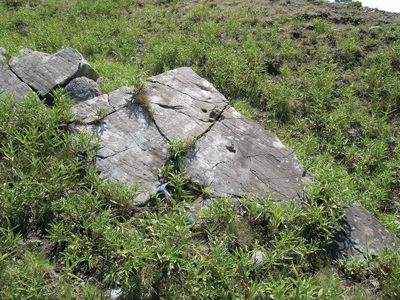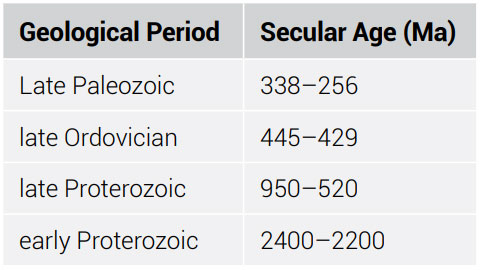Journal of Creation 32(1):13–15, April 2018
Browse our latest digital issue Subscribe
At least some ‘tillites’ may be impact debris

Figure 1. Striated pavement from a landslide, now left as a remnant on top of the Gravelly Mountains, Southwest Montana, USA.
Uniformitarian earth scientists have presented creation scientists with many challenges. Each challenge must be addressed in detail before it becomes clear that the particular features claimed as proof of ‘millions/ billions of years’ are no such thing. Often, such investigation also ends up challenging uniformitarian ideas. Indeed, creation scientists often find a reasonable solution, one that fits better in the Creation/Flood model than uniformitarianism, even given our limited manpower and funds.1 An example of one such claim is that ancient ice age deposits, called ‘tillites’, prove the necessity for millions of years.2,3
The challenge of tillites
Tillites are defined as a consolidated glacial till; a mixture of rocks of all sizes within a finer-grained matrix deposited by glacial ice. Processes apart from glacial ice can produce till-like rocks. If the origin of the till-like debris is uncertain it is called a diamicton when it is loose and unconsolidated and a diamictite when it is lithified (transformed into stone). Tillites by this definition are rather numerous.
Besides a texture of rocks of all sizes within a finer-grained matrix, other glacial-like features are sometimes associated with tillites. They include:
- striated and grooved bedrock,
- striated, faceted, and/or polished rocks, and
- outsized rocks4 within finer-grained sedimentary rocks.
These features are considered ‘diagnostic’ of glaciation, since they are commonly associated with the ‘Pleistocene’ ice ages (the post-Flood Ice Age).
Other more minor features are also claimed as diagnostic, such as nailhead striations, which are striations or grooves that start abruptly on a bedding plan. Nailhead striations are thought to have formed when a rock in a moving glacier sinks down to the base and scratches the substrate. Combined with the features commonly regarded as diagnostic of glaciation, these give the impression of overwhelming evidence for tillites formed by multiple ice ages through geological history. These ancient ice ages, all before the ‘Pleistocene’ ice age are mostly fitted into four main time periods (table 1).

The challenge of ancient tillites for creationist geology is that widespread glaciations are not plausible to have occurred during Noah’s Flood, when most of the rocks would have formed in that paradigm.
Responses to the problem of tillites
However, several responses to the challenge of tillites are possible, all centred on the conclusion that the tillites were not formed by glacial ice. First, numerous problems with the glacial interpretation have been revealed by both secular scientists6 and creation scientists.2,7,8 For instance, landslides either on land or on the ocean bottom can duplicate the till-like texture of the debris, and the three main diagnostic features.2 An Eocene debris flow exists now as a remnant on top of the Gravelly Mountains of Southwest Montana, USA. This debris flow duplicates two of the three supposedly diagnostic features of glaciation: striated bedrock (figure 1) and striated stones. Since the Eocene is considered by secular scientists to have been very warm, this debris flow, once thought to have been caused by a glacier, is now claimed to be from a non-glacial landslide.
Interestingly, the tillites are predominantly from low paleolatitude and marine deposits.9 Because of this discovery, some of the Precambrian ‘ice ages’ are deduced to have been global. This is called the snowball or slushball Earth, and has enough problems for it to be deemed impossible by many.10
Moreover, creationists have offered non-glacial interpretations of tillite-like deposits. For instance, creationists have proposed that gigantic landsliding during the Flood can explain tillite-like deposits. Flood landslides can account for the large scale of some of the tillites, like the Dwyka tillite that occupies the bottom of the Karoo Basin, southern Africa, over an area about 1,300 km by 600 km.2 It can also explain why practically all tillites are considered to be marine mass flows. Landsliding would have been a common occurrence during the Flood, considering the rapid accumulation of sediments and the magnitude of the tectonics.
Tillites from impacts
However, the above possibilities that have been offered by creationists are not exhaustive. Another that is worth considering as we investigate diamicton and diamictite formations in the field is that some may have formed from meteorite or comet impacts. This idea had been put forward by some researchers in the 1990s,11,12 but the idea was strongly challenged by others.13-15
In a recent article,16 Rampino points out again that all the major diagnostic features can be duplicated by nonglacial processes, especially when they are found at geological times when the climate was supposedly universally warm, such as the Mesozoic era, within the evolutionary timescale. Rampino emphasizes that even the ‘best’ diagnostic criterion, outsized rocks within fine-grained sediment, can be duplicated by various types of mass flows, ranging from debris flows to turbidity currents. Nailhead grooves can also be produced by mass flow.
Moreover, in his recent article Rampino continues to suggest that some of these tillites could be impact debris.16 In his view, given the millions of years of evolution, there should be more impact debris found in the rocks. He adds that striated and grooved bedrock and nailhead striations are rarely found below the claimed tillites. Interestingly, they are found associated with some impact debris, such as the Bunte breccia from the Reis impact in Germany.17
Although Rampino previously challenged the origin of most tillites,12 in Rampino’s latest article he narrowed his focus to the late Precambrian tillites, suggesting they may be impact debris. This could be due to a more comprehensive examination of the rocks in the most famous late Paleozoic ‘tillite’, the Dwyka tillite in southern Africa, in which no shock effects were found.13 Moreover, shock features are lacking with other tillites, creating a significant difficulty for Rampino’s suggestion of impact genesis. It is possible the field workers may have failed to look for them. Rampino points out that shocked rocks are also rare in known impact debris, and hence shocked rocks are a poor diagnostic criterion for impacts. He earlier claimed that shocked quartz was found in a rock from a late Precambrian tillite from southern Utah, but critics explained it away as possibly eroded from an older impact deposit, which seems unlikely.
Rampino also suggests a new impact-diagnostic feature, rocks showing brittle failure, and points out that these have been found in the Precambrian during ‘non-glacial intervals’. He concludes:
“The recognition that a number of diamictites in the geological record interpreted as tillites have a subaqueous debris-flow origin and the fact that some features ascribed to glaciation may not be entirely diagnostic suggests that a reinterpretation of some supposedly glacial tillites as non-glacial debris-flow/debris-fall deposits may be necessary.”18
Conclusion
Mechanisms other than glacial ice have been found to produce tillite-like features. These include landsliding and impacts, and provide a viable explanation for how some ancient tillites were formed, one that fits within the Flood paradigm. It is not unusual for young earth researchers to discover alternative explanations for ‘old earth’ features within the uniformitarian literature itself. Creation scientists should continue to read all we can on a particular challenge. It is also important that we continue to undertake our own field work in case secular scientists missed what they did not expect to find. Answering challenges takes time, patience, and faith. We should not expect to answer all challenges to the Flood model since earth science itself is a developing field. This is attested by the tens of thousands of earth scientists worldwide doing research on unknowns and unsolved problems within their model. Creation science is only starting to develop a sophisticated Flood model and exciting discoveries remain to be made.
References and notes
- Oard, M.J. and Reed J.K. (Eds.), Rock Solid Answers: The biblical truth behind 14 geological questions, Master Books and Creation Research Society Books, Green Forest, AR and Chino Valley, AZ, 2009. Return to text.
- Oard, M.J., Ancient Ice Ages or Gigantic Submarine Landslides? Creation Research Society Books, Chino Valley, AZ, 1997. Return to text.
- Oard, M.J., The challenge of ancient ice ages answered, Creation 38(1):48–50, 2016. Return to text.
- An outsized rock is one that is larger than the layers of sediment and often shows the layers bowed around the rock. It is assumed to be a dropstone from an iceberg that floated out over the ocean or a lake, where fine-grained sediments were being deposited. Return to text.
- Crowell, J.C., Pre-Mesozoic Ice Ages: Their bearing on understanding the climate system, GSA Memoir 192, Geological Society of America, Boulder, CO, 1999. Return to text.
- Schermerhorn, L.J.G., Late Precambrian mixtites: glacial and/or non-glacial? American J. Science 274:673–824, 1974. Return to text.
- Molén, M., Diamictites: ice ages or gravity flows? in: Walsh, R.E. and Brooks, C.L. (Eds.), Proceedings of the Second International Conference on Creationism, Volume II, Creation Science Fellowship, Pittsburgh, PA, pp. 177–190, 1990. Return to text.
- Sigler, R. and Wingerden, V., Submarine flow and slide deposits in the Kingston Peak Formation, Kingston Range, Mojave Desert, CA: evidence for catastrophic initiation of Noah’s Flood; in: Walsh, R.E. (Ed.), Proceedings of the Fourth International Conference on Creationism, technical symposium sessions, Creation Science Fellowship, Pittsburgh, PA, pp. 487–501, 1998. Return to text.
- Oard, M.J., Landslides win in a landslide over ancient ‘ice ages’; in: Reed J.K. and Oard, M. (Eds.), Rock Solid Answers: The biblical truth behind 14 geological questions, Master Books and Creation Research Society Books, Green Forest, AR and Chino Valley, AZ, pp. 111–123, 2009. Return to text.
- Oard, M.J., ‘Snowball earth’–a problem for the supposed origin of multicellular animals, J. Creation 16(1):6–9, 2002. Return to text.
- Oberbeck, V.R., Marshall, J.R., and Aggarwal, H., Impacts, tillites, and the breakup of Gondwanaland, J. Geology 101:1–19, 1993. Return to text.
- Rampino, M.R., Tillites, diamictites, and ballistic ejecta of large impacts, J. Geology 102:439–456, 1994. Return to text.
- Reimold, W.U., von Brunn, V., and Koeberl, C., Are diamictites impact ejecta?—no supporting evidence from South African Dwyka Group diamictite, J. Geology 105:517–530, 1997. Return to text.
- Young, G.M., Impacts, tillites, and the breakup of Gondwanaland: a discussion, J. Geology 101:675–679, 1993. Return to text.
- Le Roux, J.P., Impacts, tillites, and the breakup of Gondwanaland: a second discussion, J. Geology 102:483–485, 1994. Return to text.
- Rampino, M.R., Are some tillites impact-related debris-flow deposits? J. Geology 125:155–164, 2017. Return to text.
- Hörz, F., Ostertag, R., and Rainey, D.A., Bunte breccia of the Ries: continuous deposits of large impact craters, Reviews of Geophysics and Space Physics 21(8):1,667–1,725, 1983. Return to text.
- Rampino, ref. 16, pp. 161–162. Return to text.







Readers’ comments
Comments are automatically closed 14 days after publication.